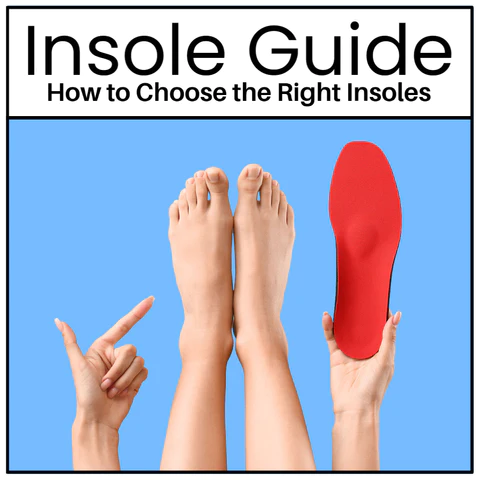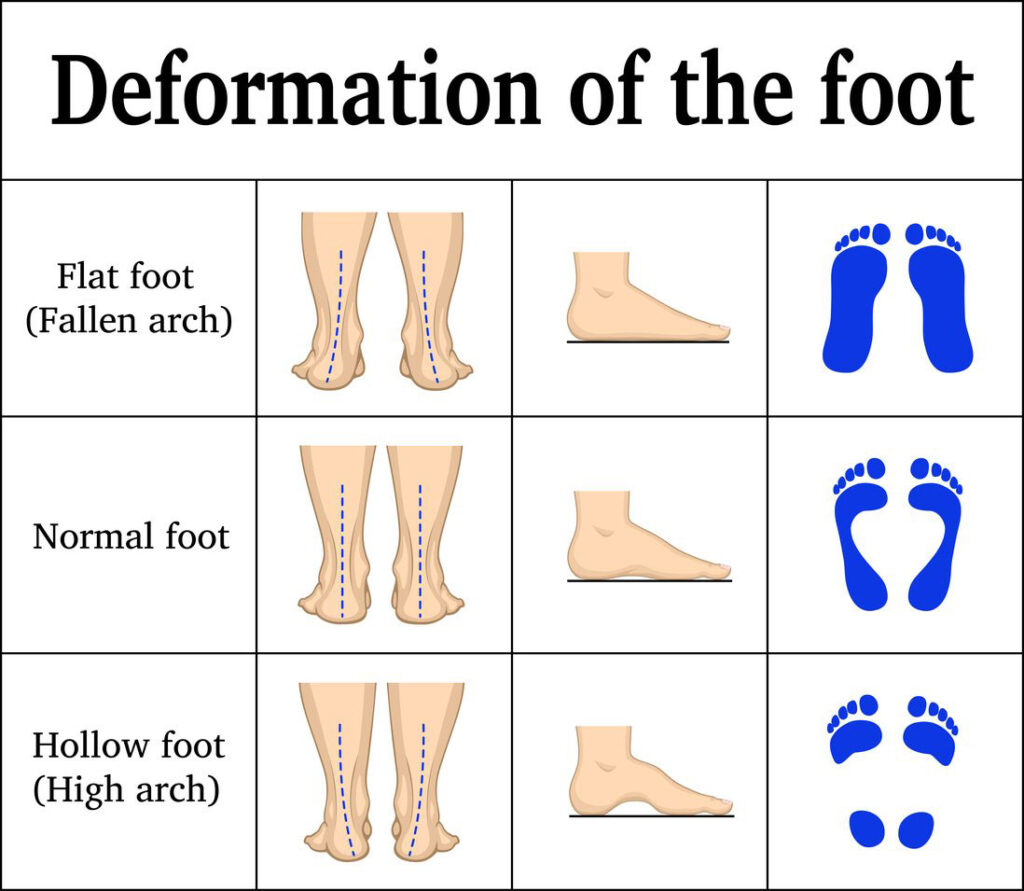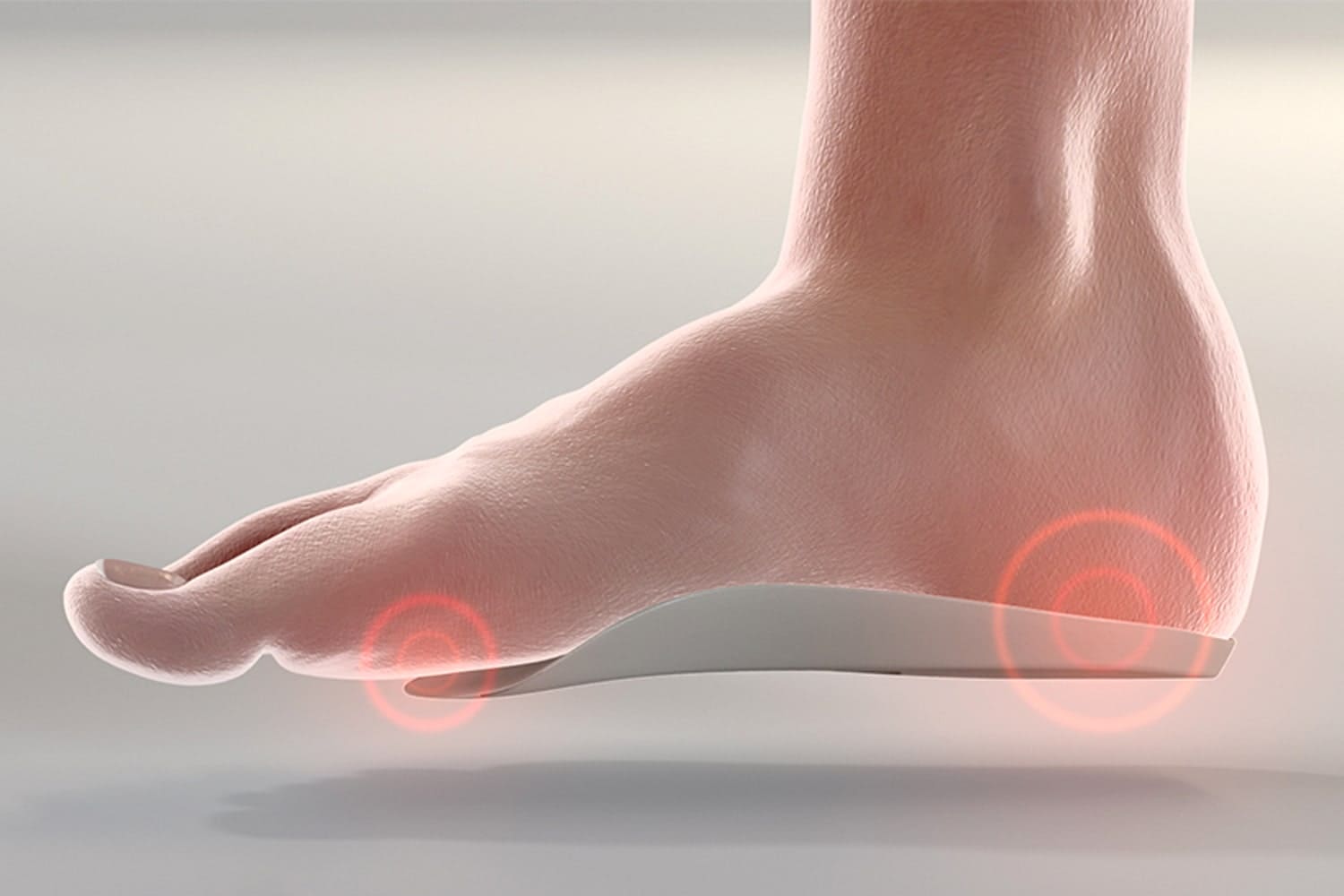Ensure foot comfort and prevent injuries by choosing the right arch support for your feet. Discover how to identify your arch type and select the perfect support for your lifestyle.
Introduction to Arch Support
Your feet are the foundation of your body, carrying you through daily life with every step. But not all feet are the same, and understanding the importance of supporting your unique arch can make a significant difference in your overall comfort and health. This guide delves into the world of arch support, exploring how to choose the right type for your feet to enhance comfort, improve posture, and prevent common foot-related issues.
Table of Contents
Identifying Your Arch Type
Low Arch (Flat Feet)
People with low arches or flat feet tend to have a minimal visible arch area, meaning their soles almost entirely touch the ground. This arch type can lead to overpronation, where the foot rolls inward excessively when walking or running. Signs that you might have flat feet include uneven shoe wear, especially on the inside of the sole, and experiencing pain or fatigue in your feet, legs, hips, or back after standing for long periods.
To determine if you have flat feet, you can perform the wet test: wet your feet, step onto a piece of paper, and then step off. If your footprint shows almost the entire foot, including the arch area, you likely have low arches.

Normal Arch (Medium)
A normal arch typically presents a well-defined curve along the inside of the foot. Individuals with this arch type have a balanced, even distribution of weight across the foot when standing and walking. This balance means they are less likely to experience overpronation or supination (outward rolling of the foot). The wet test for a normal arch will show a distinct curve along the inside of the foot with a band a little less than half the width of the foot connecting the heel and toe.
High Arch
High arches are characterized by a more significant curve along the inside of the foot, with a narrow band connecting the heel and forefoot in the wet test. This arch type can lead to supination, where the foot rolls outward, placing extra stress on the outer foot and ankle. Symptoms of having high arches include pain and instability in the feet, calluses or bunions on the outer side of the foot, and ankle sprains or injuries.
Understanding your arch type is vital for selecting appropriate footwear and arch supports. For instance, individuals with low arches may benefit from supports that provide stability and help prevent overpronation. Those with normal arches might look for moderate support for overall comfort, while individuals with high arches might need supports that offer cushioning and help distribute pressure more evenly across the foot.
No matter your arch type, ensuring that your shoes and arch supports match your specific needs can lead to a significant improvement in foot comfort and overall mobility. If you’re unsure about your arch type or the right type of support for you, consulting with a podiatrist or a foot care specialist can provide personalized advice and recommendations.
Benefits of Choosing the Right Arch Support
Enhanced Comfort and Stability
The most immediate benefit of choosing the right arch support is the increase in comfort it provides. Proper arch support helps distribute your body weight more evenly across your feet, reducing pressure points and the strain on your feet during daily activities. This even distribution of weight also contributes to greater stability, reducing your risk of slips, trips, and falls, particularly on uneven surfaces.
Prevention of Foot-Related Injuries
Inadequate arch support can lead to overpronation or supination, as mentioned earlier, which in turn can increase the risk of foot-related injuries such as plantar fasciitis, Achilles tendonitis, and shin splints. By selecting arch supports that cater to your specific arch type, you significantly reduce the risk of these conditions by ensuring your feet are aligned and moving correctly.
Improved Posture and Gait
Your feet are the foundation of your posture. When that foundation is properly supported, it can have a cascading positive effect on your entire body. The right arch support helps align your ankles, knees, and hips, leading to a more natural and efficient walking pattern (gait). This alignment can also help correct and prevent posture-related issues, reducing discomfort and pain in your back, neck, and shoulders.
Reduction in Pain and Discomfort
For those already suffering from foot pain or conditions related to poor arch support, making the switch to appropriate arch supports can offer significant relief. Conditions such as arch pain, heel pain, and ball-of-foot pain can be directly addressed by providing your feet with the support they need, thereby reducing the pain and discomfort associated with these issues.
Enhanced Athletic Performance
For athletes or anyone engaged in regular physical activity, the right arch support is essential for maximizing performance and preventing injury. Proper support can improve foot response, balance, and stability during high-impact activities, enhancing overall athletic performance. It also reduces muscle fatigue, allowing for a more extended period of activity with less discomfort.
Long-term Joint Health
Continuous use of proper arch support can contribute to better joint health in the long run. By aligning your feet and distributing your weight evenly, you reduce the undue stress on your ankles, knees, and hips. This preventative measure can help avoid more serious joint issues in the future, such as osteoarthritis, particularly in the knees and hips.

Types of Arch Supports
Over-the-Counter (OTC) Arch Supports
OTC arch supports are widely available and can be purchased without a prescription. They come in various sizes, shapes, and materials, offering a range of support levels from mild to firm. OTC options are typically less expensive than custom orthotics and are a good starting point for people experiencing mild foot discomfort or looking to improve their footwear comfort. They’re ideal for individuals with common foot types and mild to moderate arch support needs.
Custom Orthotics
Custom orthotics are personalized arch supports made specifically for your feet based on a podiatrist’s assessment and molds or scans of your feet. They are designed to address more complex or severe foot issues, such as significant overpronation, supination, plantar fasciitis, or foot pain resulting from diabetes. Custom orthotics are more expensive than OTC options, but their personalized design offers targeted support and cushioning, making them a worthwhile investment for those with specific foot health needs.
Gel Arch Supports
Gel arch supports provide cushioning and shock absorption, making them an excellent choice for people who stand for long periods or are involved in activities that put a lot of stress on the feet. The gel material molds to the shape of your foot, offering a comfortable, customized fit. However, while they excel in cushioning, they may not offer as much structural support as other materials.
Foam Arch Supports
Foam arch supports are known for their comfort and adaptability. They provide a soft, cushioned layer that can help reduce foot fatigue and discomfort during extended periods of standing or walking. Foam supports are particularly beneficial for individuals with sensitive feet or conditions like arthritis. However, they may compress over time and require replacement more frequently than other materials.
Hard Plastic or Carbon Fiber Arch Supports
Arch supports made from hard plastic or carbon fiber are the most rigid and offer the highest level of support. They are best suited for individuals with significant foot alignment issues or those who require substantial arch support. These materials maintain their shape over time, providing consistent support but may take some time to get used to because of their rigidity.
Cork Arch Supports
Cork arch supports strike a balance between firm support and cushioning comfort. Cork is durable and provides a good level of support while also being flexible enough to offer some shock absorption. These are a good choice for those looking for a natural material with a moderate level of support.
Selecting Arch Supports for Different Activities
For Running and Sports
- Running: Running can put a lot of stress on your feet, especially if you’re a frequent runner. Look for arch supports specifically designed for running shoes. They should provide ample cushioning and shock absorption to reduce the impact on your feet and joints. Consider supports that offer motion control if you tend to overpronate or supinate while running.
- Athletic Activities: If you participate in a variety of sports or athletic activities, consider arch supports that offer versatility. Look for options that fit well in different types of athletic shoes, providing both support and comfort. Custom orthotics may be an excellent choice if you have specific foot issues that need addressing.
- Impact Sports: Sports like basketball, tennis, and volleyball involve quick movements, jumps, and sudden stops. Arch supports with enhanced cushioning and stability are essential for these activities. Gel or foam supports can provide the necessary shock absorption and comfort.
For Everyday Wear and Work
- Casual Shoes: For everyday casual wear, you’ll want arch supports that fit comfortably in a variety of shoe styles, from sneakers to loafers. Look for thin, flexible supports that won’t alter the fit of your shoes but still provide adequate arch support for all-day comfort.
- Work Shoes: If your job requires you to stand or walk for extended periods, invest in arch supports specifically designed for work shoes. These supports often provide extra cushioning and support to reduce fatigue and prevent foot pain. Consider custom orthotics if you have a demanding job that places stress on your feet.
- Dress Shoes: Dress shoes tend to have less arch support, so consider purchasing slim, orthotic-friendly insoles that can fit comfortably in your dress shoes without altering their appearance. These insoles can provide much-needed support during formal occasions.

How to Fit Arch Supports
Regardless of the activity, it’s essential to ensure your arch supports fit correctly in your shoes. Follow these steps to fit your arch supports properly:
- Remove Existing Insoles: If your shoes have removable insoles, take them out before inserting your arch supports.
- Align the Arch: Position the arch support so that the highest point of the arch aligns with the natural curve of your foot.
- Secure Placement: Ensure that the arch supports lie flat and securely in your shoes. They should not move around or bunch up.
- Comfort Check: Put on your shoes with the arch supports and walk around to assess the comfort and fit. Make adjustments as needed.
- Consider Sock Thickness: Keep in mind that the thickness of your socks can affect the fit of your arch supports. Make sure they still fit comfortably with your preferred socks.
- Replace as Needed: Over time, arch supports can wear out. Replace them when they no longer provide the support and comfort you require.
How to Fit Arch Supports
1. Remove Existing Insoles (If Applicable):
Before inserting your arch supports, check if your shoes have removable insoles. If they do, take them out to create space for the arch supports. Some shoes, especially athletic shoes, have removable insoles that are designed to accommodate additional support.
2. Align the Arch Support:
Hold the arch support in your hand and identify the highest point of the arch. This point should align with the natural curve of your foot’s arch. It’s essential to position the arch support correctly to provide the right level of support for your foot’s specific needs.
3. Insert the Arch Support:
Gently slide the arch support into your shoe, positioning it in the arch area. Ensure that it lies flat and evenly within the shoe. The arch support should fit snugly without causing any discomfort or pressure points.
4. Check for Proper Placement:
Once the arch support is in place, press down on it to make sure it sits securely and doesn’t move around inside the shoe. It should be stable and not bunch up or slide from side to side.
5. Put on Your Shoes:
With the arch supports properly inserted, put on your shoes as you normally would. Ensure that your feet rest comfortably on the arch supports and that your toes have enough room in the toe box of the shoes.
6. Walk and Assess Comfort:
Take a few steps and walk around to assess the comfort and fit of the arch supports. Pay attention to any areas of discomfort or pressure. Your feet should feel supported, and there should be no slipping or sliding of the arch supports.
7. Make Adjustments (If Necessary):
If you experience discomfort or feel that the arch supports are not fitting correctly, you may need to make some adjustments. Here are some common adjustments you can try:
- Re-position the arch supports to ensure they align with your arches.
- Experiment with different types of arch supports or insoles to find the best fit for your feet and shoes.
- Consider trying a different size or thickness of arch supports if available.
- If you continue to experience discomfort, consult with a podiatrist or foot specialist for personalized guidance and recommendations.
8. Consider Sock Thickness:
Keep in mind that the thickness of your socks can affect the fit of your arch supports. Ensure that your arch supports still fit comfortably with your preferred socks.
9. Monitor Wear and Tear:
Over time, arch supports may wear out and lose their effectiveness. It’s important to regularly inspect them for signs of wear and replace them when they no longer provide the support and comfort you require.
Common Mistakes to Avoid
1. Choosing Style Over Function:
One of the most common mistakes is prioritizing the style and appearance of shoes over their functionality. While fashionable footwear is appealing, it’s essential to select shoes that provide adequate support and comfort. Don’t sacrifice foot health for style; find a balance that suits both your fashion preferences and your foot’s needs.
2. Ignoring Professional Advice:
Many people try to self-diagnose their foot issues and select arch supports without seeking professional advice. If you’re experiencing persistent foot pain or have specific foot conditions, consult with a podiatrist or foot specialist. They can provide a proper diagnosis and recommend the most suitable arch supports for your specific needs.
3. Neglecting Arch Type Assessment:
Choosing arch supports without considering your foot’s arch type is a common mistake. Arch supports are designed to cater to different arch types, and using the wrong type can lead to discomfort and exacerbate existing issues. Determine your arch type, whether it’s low, normal, or high, before selecting the appropriate support.
4. Incorrect Sizing:
Selecting the wrong size of arch supports can lead to discomfort and may not provide the necessary support. Always follow sizing guidelines provided by the manufacturer or consult with a fitting expert to ensure you get the right size for your feet.
5. Using Worn-Out Supports:
Arch supports have a lifespan, and using them beyond their effective period can lead to reduced support and comfort. Inspect your arch supports regularly for signs of wear and tear, and replace them as needed. It’s better to invest in new supports than to continue using old, ineffective ones.
6. Not Gradually Adapting to Them:
If you’re new to arch supports, it’s essential to give your feet time to adapt. Wearing them for extended periods right away can cause discomfort. Start by wearing them for shorter durations and gradually increase the time as your feet adjust.
7. Neglecting Shoe Fit:
Arch supports can alter the fit of your shoes. If your shoes are too tight or too loose with the arch supports in place, it can lead to discomfort and blisters. Ensure that your shoes accommodate the added bulk of the arch supports while still providing a comfortable fit.
8. Overlooking Regular Maintenance:
Proper maintenance of your arch supports is essential for their longevity and effectiveness. Neglecting to clean or care for them can result in odor and deterioration. Follow the manufacturer’s guidelines for cleaning and maintenance, and replace them when necessary.
9. Not Seeking Professional Help for Severe Issues:
If you have severe foot issues or chronic pain, relying solely on over-the-counter arch supports may not provide adequate relief. Consult with a healthcare professional who can recommend custom orthotics or other specialized treatments to address your specific concerns.
10. Using One Pair for All Shoes:
Different shoes serve different purposes, and one pair of arch supports may not work well in all types of footwear. Consider investing in multiple pairs of arch supports tailored to various shoe styles and activities.

Success Stories: Before and After
Success Story 1: Sarah’s Journey to Pain Relief
Before: Sarah, a dedicated nurse, used to endure excruciating foot pain after long shifts at the hospital. Her feet would ache, and she often experienced sharp pain in her arches and heels. The pain was affecting her job performance and her overall quality of life. She tried various over-the-counter insoles, but none provided the relief she desperately needed.
After: Determined to find a solution, Sarah consulted a podiatrist who diagnosed her with plantar fasciitis. She was prescribed custom orthotic arch supports tailored to her specific foot shape and arch type. The transformation was remarkable. After a few weeks of wearing the custom arch supports in her work shoes, Sarah noticed a significant reduction in foot pain. Her daily shifts became more bearable, and she could focus on her patients without constant discomfort. The “after” was a happier, pain-free Sarah who could once again enjoy her active lifestyle outside of work.
Success Story 2: Mike’s Struggle with Overpronation
Before: Mike, an avid runner and fitness enthusiast, was no stranger to foot and knee pain. He had flat feet and overpronated, causing him to experience pain in his arches, shins, and knees. He tried various running shoes, but the pain persisted, affecting his passion for running.
After: Mike decided to visit a sports medicine specialist who recommended a gait analysis and custom orthotic arch supports. After a thorough assessment, he received arch supports that corrected his overpronation and provided cushioning where he needed it most. The transformation was astounding. Mike’s “after” involved pain-free runs, improved running performance, and a newfound love for his favorite hobby. He was no longer held back by discomfort and could pursue his fitness goals with enthusiasm.

Choosing the Right Arch Support for Your Feet
1. Identify Your Arch Type:
Begin by determining your arch type, which can be categorized as low (flat feet), normal (medium arches), or high arches. Knowing your arch type is fundamental in choosing the appropriate support.
- Low Arch (Flat Feet): If you have flat feet, look for arch supports that provide stability and help prevent overpronation (excessive inward rolling of the foot).
- Normal Arch (Medium): Individuals with medium arches can benefit from moderate arch supports that offer balanced comfort.
- High Arch: High arches require arch supports with cushioning and shock absorption to distribute pressure evenly across the foot.
2. Assess Your Foot Condition:
Consider any existing foot conditions or issues you may have, such as plantar fasciitis, bunions, or Achilles tendonitis. Consult with a podiatrist or foot specialist if necessary to determine the best type of support for your specific condition.
3. Choose the Right Material:
Arch supports are available in various materials, including foam, gel, cork, hard plastic, and custom orthotics. Each material offers different levels of support and cushioning. Select the material that aligns with your comfort preferences and the level of support you require.
- Foam: Provides cushioning and is suitable for individuals seeking comfort during everyday activities.
- Gel: Offers excellent shock absorption and is ideal for reducing fatigue during long periods of standing or high-impact activities.
- Hard Plastic or Carbon Fiber: Delivers rigid support and is beneficial for correcting severe foot alignment issues.
- Custom Orthotics: Personalized arch supports tailored to your foot’s unique shape and needs.
4. Consider Activity and Shoe Type:
Take into account the activities you engage in regularly and the types of shoes you wear. Different activities and shoe styles may require specific arch supports.
- Running or Athletic Activities: Choose arch supports designed for sports and running shoes, providing motion control and shock absorption.
- Casual or Work Shoes: Opt for arch supports that fit comfortably in everyday shoes without altering the fit.
- Dress Shoes: Look for slim, orthotic-friendly insoles to maintain a professional appearance.
WHERE TO BUY
FAQs About Arch Supports
- How do I know if I need arch support?
- Can arch supports help with foot pain?
- How long do arch supports typically last?
- Are custom orthotics better than over-the-counter arch supports?
- Can I wear arch supports in all my shoes?
- What should I do if my arch supports are uncomfortable?
Conclusion: Embracing Comfort and Support
Choosing the right arch support for your feet is a step towards a healthier, more comfortable life. With the right information and approach, you can find the perfect support for your needs, embracing a future of improved mobility and reduced pain. Remember, your feet carry you through life; it’s time to give them the support they deserve.











Your article helped me a lot, is there any more related content? Thanks!